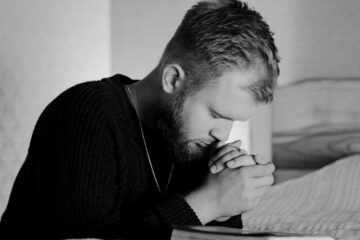Lambros Skontzos, Theologian
Thessaloniki has been the cradle of many saints. There are hundreds of Thessalonian saints who adorn the holy synaxaria. One such saint is Theonas, archbishop of the city, a truly significant personality who made his mark in the Thessaloniki of the 16th century.
We don’t have much by way of information regarding his early years, nor do we know exactly where he was born, though tradition has it that the event occurred on Lesvos, at the end of the 15th century. It may also be that he was called Lesvios because he served as confessor on the island, at Plomari, at the beginning of his priestly ministry. We don’t know the names of his parents, but we may reasonably suppose that they were devout people.
We do have the information that as a young man Theonas left to go to the Holy Mountain, where he was tonsured as a monk and ordained as a priest in the Skete of Saint Onoufrios, belonging to the Monastery of Iviron. It was there that he began his personal struggle to cleanse himself of the passions. He prayed for hours, kept vigils and fasted. Because he loved quietude and silence, he would take a few provisions and head off to a deserted spot where he could pray without interruption- firstly, for the whole world, and lastly for himself. He prayed particularly for the enslaved nation of the Greeks, who were groaning under the oppression of the heathen Ottomans.
There he met a virtuous elder (later saint) Iakovos, whose disciple and subordinate he became. From Iakovos he learned the secrets of the life in Christ. Every day he ascended gradually towards spiritual perfection. He made his body dead to the world and lived as an angel.
In 1518, Elder Iakovos gathered his disciples and revealed a vision, according to which he was called to go to the Monastery of the Honorable Forerunner in Dervekistas, near Thermos in Aitolia, because the region was in need of spiritual revival. They were called upon to work spiritually among the people there who were languishing in deep darkness because of the Turkish yoke. Theonas asked to go with him and did so with great joy. When they arrived at Nafpaktos they looked for the monastery. Each evening the two monks saw a heavenly light stretching out over a particular area. This light was also seen by the few monks of the monastery, as well as by residents of the surrounding area. They took it as a sign that something good was about to happen.
After a three-day journey on foot, with the light as a guide, the two Athonites reached the monastery, where they received a rapturous welcome from the brotherhood. They considered it a great blessing to have spiritual men with them from the ‘Bower of our Lady’, sent by God. Iakovos withdrew to a nearby cave to live as a hermit. Every Sunday he would go down to the monastery to take communion and teach the monks. Many Christians flocked to the monastery to get the elder’s blessing and to confess. Theonas was sent to Metropolitan Akakios of Arta to obtain his license as a confessor and to seek help for the monastery. He was granted his license, as well as significant financial assistance for the Monastery of the Honorable Forerunner, which was transformed into spiritual beacon for the region as a whole. A host of people flocked to Elder Iakovos and Theonas to confess and to be given their advice and their blessing. However, the wicked devil resented the work of the monastery and wanted to destroy it. Some wretched slanderers went to Arta and persuaded the bishop to report the monastery to the Turkish authorities as being a hotbed of revolt. Elder Iakovos was arrested and taken to Trikala, in Thessaly, to appear before the bey. Theonas followed him loyally. Although the bey was convinced that the charges were unjust, he nevertheless imprisoned Elder Iakovos. Theonas was his unfailing support and visited him in prison, where he looked after him.
On the order of the sultan, the bey of Trikala sent Elder Iakovos to be tried in Adrianoupolis, where he was condemned and martyred, together with Hierodeacon Iakovos and the monk Dionysios, on 1 November 1520.
Theonas returned to the Monastery of the Honorable Forerunner, where he became abbot and worthily continued the spiritual, social and national work of his Elder. But again the cantankerous Metropolitan Akakios of Arta, at the behest of corrupt people, dissolved the monastery and expelled the community in the middle of winter. They were welcomed as guests until the spring by one of the leading figures in the area.
In 1522, Theonas and his brotherhood went to the Holy Mountain and settled in the Monastery of Simonos Petras. But they were unable to thrive there because the Turks had pillaged the monastery and the monks were starving. They therefore left and made their way to Galatista, in Halkidiki, where they renovated the Monastery of Saint Anastasia, the Deliverer from Potions, where Theonas became abbot. On information provided by a priest from Arta, they discovered the relics of the new martyrs Iakovos, Iakovos the hierodeacon and Dionysios the monk, which they took back to the monastery. The foundation became well known and lots of people hastened to receive the blessing of Theonas, who was now established as an outstanding spiritual figure. He taught and took confession all the time. Alongside him, another great personality served, the famous teacher Theofanis, who, in 1560 was consecrated Archbishop of Paronaxia.
God had destined Theonas for a higher ministry, however. The clergy and laity elected him Metropolitan of Thessaloniki. From his new ecclesiastical office he performed exceptional pastoral, spiritual and charitable work, at a time of insurmountable obstacles, though he shepherded the flock in Thessaloniki for only a short time, from April 1541 to May 1542, when he departed this life in peace. His relics were taken miraculously to the Monastery of Saint Anastasia. In 1821, they were transferred to Skopelos and later to the Monastery of Esfigmenou on the Holy Mountain. His memory is honored on 4 April.
Source: pemptousia.com




0 Comments